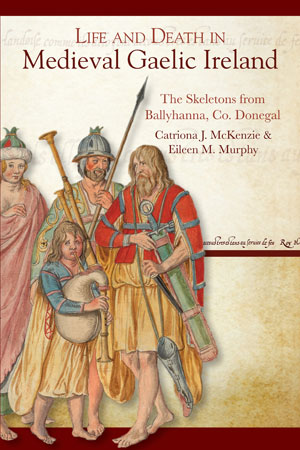LIFE AND DEATH IN MEDIEVAL GAELIC IRELAND: the skeletons from Ballyhanna, Co. Donegal
Published in Book Reviews, Book Reviews, Issue 3 (May/June 2019), Reviews, Volume 27CATRIONA J. McKENZIE and EILEEN M. MURPHY
Four Courts Press
€45
ISBN 9781846823305
Reviewed by: Áine Foley
Áine Foley is a Busteed Fellow at the Institute of Irish Studies, University of Liverpool.

In 2003 a cemetery at Ballyhanna, near Ballyshannon, Co. Donegal, was excavated, revealing the skeletal remains of almost 1,300 individuals. Radiocarbon dating established that the site was in continuous use from the seventh to the seventeenth century. Both authors worked on the Ballyhanna Research Project (BRP), which undertook a scientific study of the skeletal remains, including a detailed osteological (the study of the structure and function of bones) and palaeopathological (the study of diseases found in bones) evaluation. In this book they appraise the results of that research, divulging a wealth of information about different aspects of the lives of those who were interred in Ballyhanna.
The authors demonstrate that an analysis of the skeletons can offer us insights into various facets of their lives, including their standard of health. There is evidence, for instance, that the quality of medical care available to residents of Ballyhanna was inferior to that of individuals found at other cemeteries excavated in Ireland. The authors reveal what these remains can tell us about the type of diet they enjoyed, as well as their social status and lifestyle. Their analysis also reveals the level of violence experienced by those living in medieval Ballyhanna, and by extension provides an idea of the political stability, or lack thereof, of the region.
Only a small number of the skeletons showed evidence of weapon injuries and, perhaps unsurprisingly, the majority of these were male. The authors believe that the low number of victims of violence suggests that the injuries sustained by the people of Ballyhanna were probably not the result of large-scale battles but rather of small-scale interpersonal violence. The study of bones has its limitations, however, since injuries inflicted on soft tissue are invisible on the skeletal remains. Moreover, other forms of violent death, like poisoning or strangulation, will not be evident in skeletal remains either, so caution must be exercised when assessing cause of death. McKenzie and Murphy conclude that the lack of evidence for weapon injuries suggests that those buried in Ballyhanna were of low social status, because those at the upper levels of Gaelic society were more likely to be involved in warfare.
This is the first comprehensive study of a cemetery based in medieval Gaelic Ireland, revealing insights into the lives and deaths of the lower classes who had previously been invisible in the historical record. McKenzie and Murphy argue that the other major sites excavated, like the Dominican priories in Drogheda and Cork, as well as Ardfert Cathedral in Kerry and Ardreigh in Kildare, were in areas under the influence of the Anglo-Normans (a rather archaic term for people who referred to themselves as English throughout the later medieval period). While this is broadly true, all of these places would also have had significant Gaelic populations, particularly Ardfert, which was frequently administered by a bishop of Gaelic origin.
The analysis of the bones at Ballyhanna offers revealing glimpses not only into the everyday lives of those who lived there but also into moments of crisis and tragedy. For example, the case of a mother buried with her twins is a poignant reminder of the dangers of childbirth. The woman was small in stature and may not have been able to deliver her twins. It is unclear whether the babies were buried with her after childbirth or if they were still in utero. These accounts give the burials a human perspective, and the authors remind us that we are dealing with people and not just archaeological evidence.
The scope of this book is wide and has much to offer those with an interest in life and death in medieval Ireland. It documents the range of illnesses suffered by these people and the treatment they received for their ailments. It describes how their lives were affected by the dangers of interpersonal or intergroup violence, how risky childbirth could be for the women of the time and the care demonstrated towards members of the community at their time of death. Evidence of accidental injuries were also found on the remains, providing proof of the hard lives they experienced and the impact of physical labour on their bones. The little tokens found on the bodies tell us something of their beliefs and what was important to them, like the scallop shell found on a female skeleton. This may simply have demonstrated her religious devotion, or it might mean that she had once gone on pilgrimage, perhaps to seek healing for an ailment.
The authors are to be commended for making their scientific analyses and conclusions accessible to a more general audience, and we can only hope that other cemetery excavations will receive similar treatment.
















